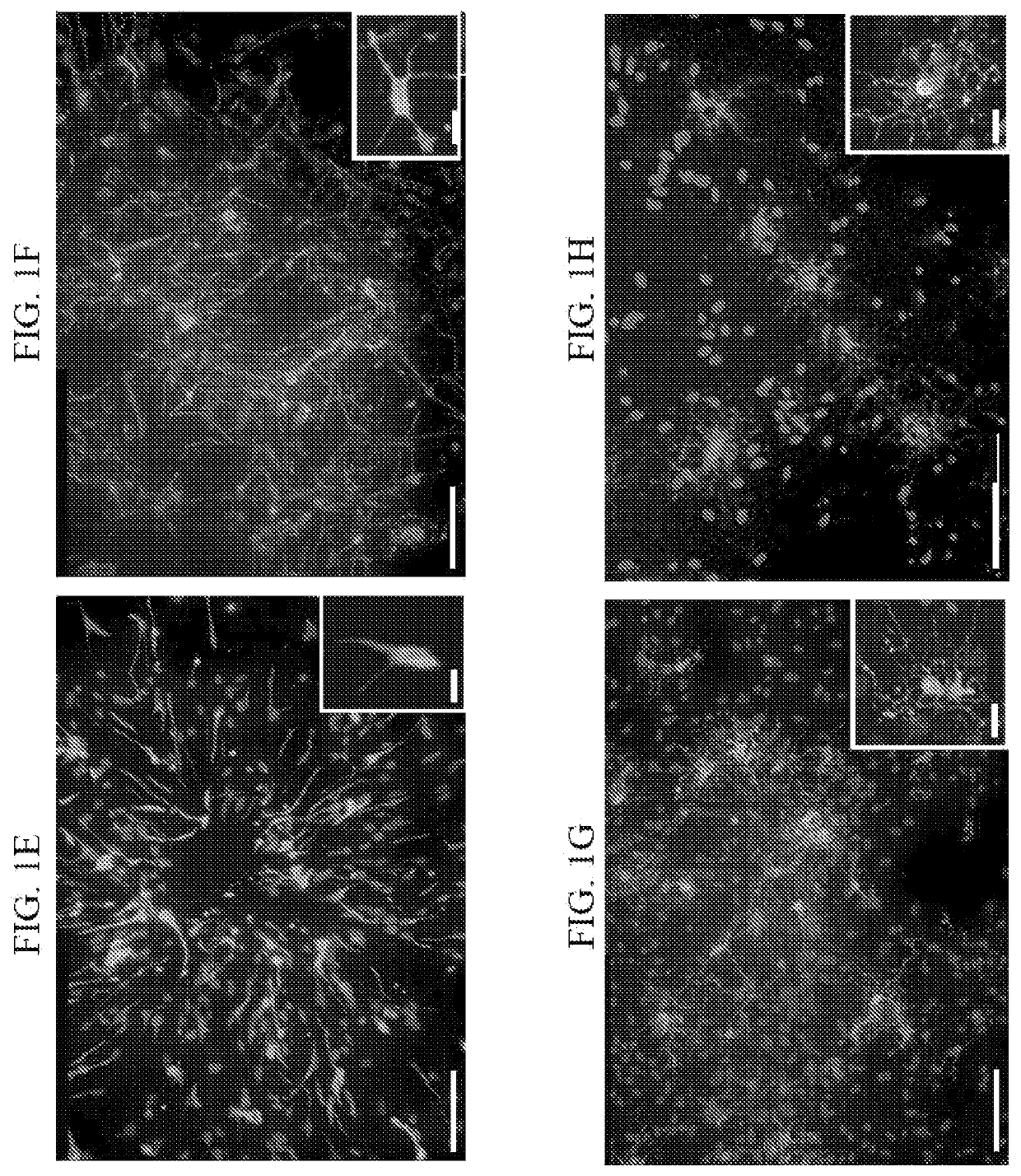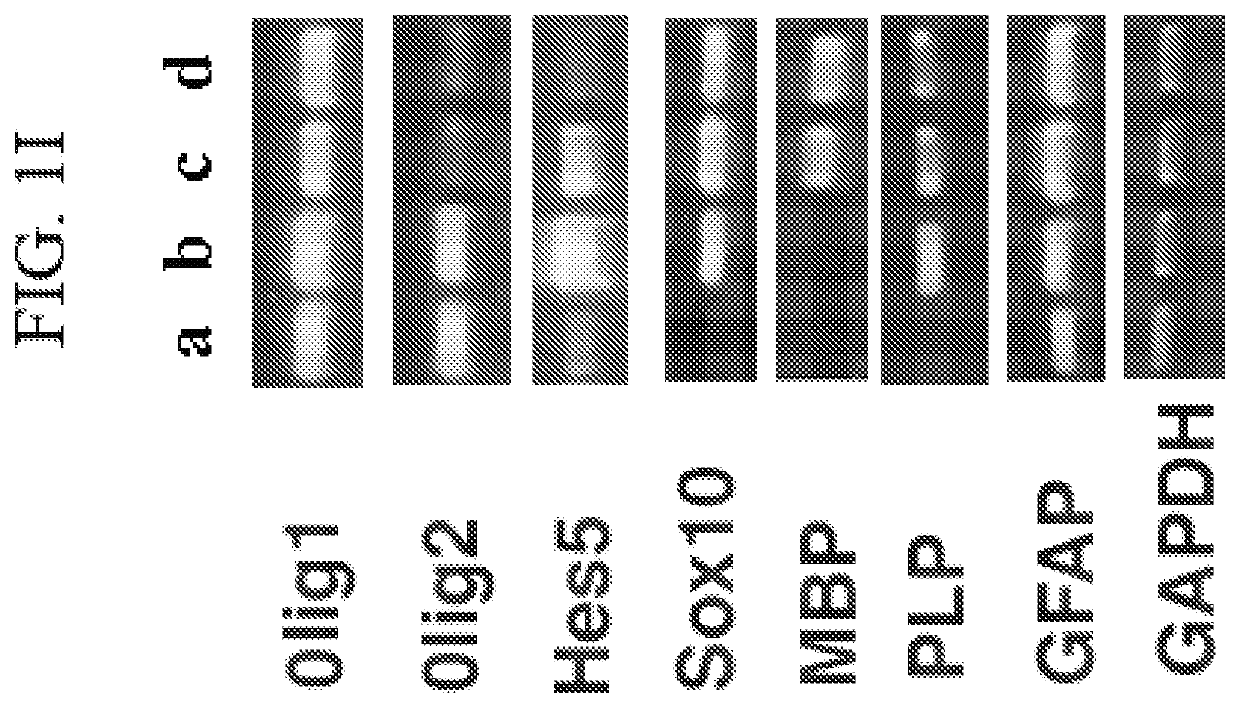Method of identifying agents that affect maturation, survival and myelination
a technology of survival and myelination, applied in the field of methods of identifying agents that affect maturation, survival and myelination, can solve the problems of human embryo use and false results of tests
- Summary
- Abstract
- Description
- Claims
- Application Information
AI Technical Summary
Benefits of technology
Problems solved by technology
Method used
Image
Examples
example 1
Generation and Characterization of Cells Used in the Myelination Assay
[0210]The human ES cells were differentiated by a stepwise protocol, where neural spheres develop and grow in suspension with EGF. Neural spheres cells were then separated from non-neural tissues by attachment to Matrigel extracellular matrix and growth with EGF. To investigate the effect of drugs on oligodendrocyte function, it is important to use well-characterized pools of human oligodendrocyte progenitor cells that may be differentiated by a simple procedure in-vitro or in-vivo. Proliferation of neural sphere cells, dissociated with trypsin, on Poly D-Lysine-coated plates for two to three passages in the presence of growth factors EGF and bFGF, yields lines of neural stem cells (NSC) available for further differentiation studies. Each line results from the dissociation of pools of neural spheres.
[0211]In-vitro and in-vivo, CNS OLs develop from NSC through a series of morphological steps, as summarized in FIGS....
example 2
Differentiation of NSCs into Multibranched OLs; Quantification of the Effect of Noggin
[0213]BMP signaling negatively regulates oligodendrocyte lineage development, and it has been shown that Noggin, an inhibitor of BMP signaling, promotes the differentiation of ES-derived oligodendrocytes. As a proof of concept that effects of drugs on oligodendrocyte differentiation can be quantified, the inventors searched for the optimal concentration of Noggin to be used to promote differentiation. NSCs at fifth passage were distributed to wells of 96 well dishes and submitted to differentiation in the absence or the presence of Noggin in serial dilutions 1:3.16 at concentrations varying from 150 ng / ml to 0.5 ng / ml (4.7×10−9 to 1.5×10−11M) in triplicate assays. After ten days without growth factors, cells were stained with O4 monoclonal antibody, and nuclei counterstained with DAPI. Noggin added after growth factor removal stimulates the emergence of OLs with longer and multiple processes versus...
example 3
Co-Culture of hES Derived OPCs and Mouse Dorsal Root Ganglia Neurons
[0214]To address mechanistic aspects of myelination in the CNS, a system of co-cultures of purified neurons and oligodendrocytes was used.
[0215]Since the hES derived OPC can differentiate to mature oligodendrocytes, the inventors asked whether these cells can myelinate neurons in-vitro or in-vivo.
[0216]As targets of myelination, mouse embryonic dorsal root ganglia (DRG) neurons were used. The DRG neurons were obtained from mouse embryonic day 13 (E13) and seeded on Matrigel and PDL-coated plates. The neurons were cultured for two weeks in the presence of NGF, and during the first week two cycles of FuDR treatment eliminated Schwann cells from the culture. Pictures of the neurons, hOPC and co-culture of both are shown in FIGS. 4E-H and schematized in FIGS. 4A-D. After two weeks a network of Neurofilament positive neurons axons was formed (FIG. 4E) and no MBP positive cells were observed on or in between the DRG neuro...
PUM
| Property | Measurement | Unit |
|---|---|---|
| concentrations | aaaaa | aaaaa |
| magnetic sorting | aaaaa | aaaaa |
| fluorescence activated cell sorting | aaaaa | aaaaa |
Abstract
Description
Claims
Application Information
 Login to View More
Login to View More - R&D
- Intellectual Property
- Life Sciences
- Materials
- Tech Scout
- Unparalleled Data Quality
- Higher Quality Content
- 60% Fewer Hallucinations
Browse by: Latest US Patents, China's latest patents, Technical Efficacy Thesaurus, Application Domain, Technology Topic, Popular Technical Reports.
© 2025 PatSnap. All rights reserved.Legal|Privacy policy|Modern Slavery Act Transparency Statement|Sitemap|About US| Contact US: help@patsnap.com



